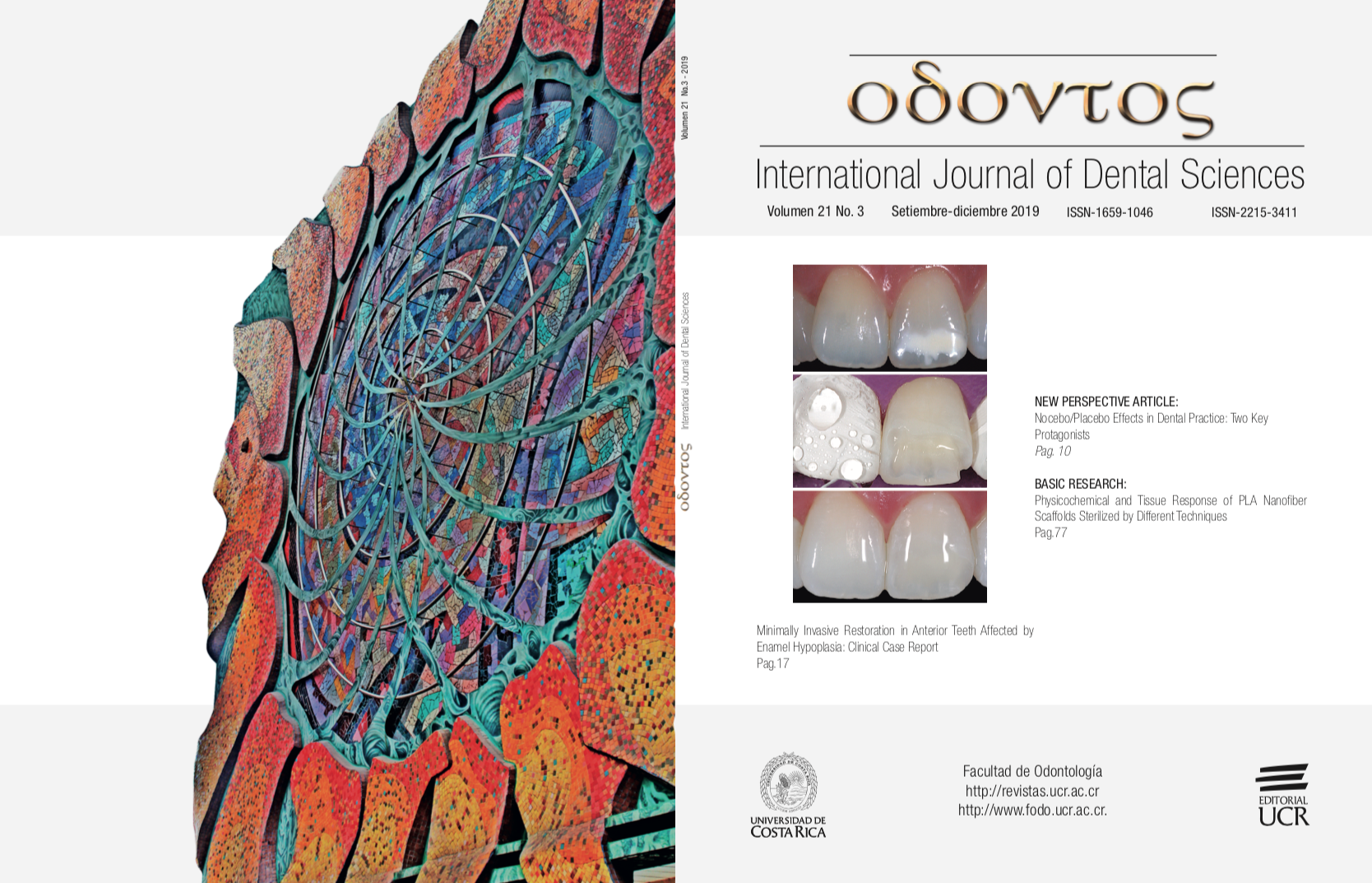Resumen
Propósito: El propósito de este estudio es evaluar la resistencia al cizallamiento (SBS) de brackets de ortodonci unidos a tres compuestos de relleno masivo diferentes que fueron envejecidos previamente. Metodología: Se incluyeron tres materiales compuestos de relleno a granel en este estudio (Filtek Bulk Fill, Tetric N-Ceram bulk fill, SureFil SDR bulk fill). Cada grupo de material contenía 12 muestras (n = 12); un total de 36 muestras se unieron de la misma manera con soportes premolares maxilares (CB; Avex Mx, OPAL orth.). Los mismos soportes de tipo se unieron en cada superficie restaurada hecha con compuestos de relleno masivo. El SBS se examinó después de almacenar las muestras durante 24 horas a 37 ºC de agua no destilada, seguido de un envejecimiento térmico (500 ciclos entre 5 ºC y 55 ºC). Los datos fueron analizados estadísticamente. Los datos numéricos se analizaron mediante el análisis de varianza (ANOVA) con pruebas post hoc de Tukey HSD en α=.05. Resultados: No hubo diferencias significativas entre los grupos compuestos (p> 0,001). Sin embargo, los valores de SBS para el grupo de control fueron significativamente mayores que los valores de resistencia al cizallamiento para los grupos compuestos (p <0.001). Conclusión: La resistencia de de brackets de ortodonci en superficies compuestas de relleno en masa no se encontró adecuada. Por lo tanto, esta situación conduce a una falla de adhesión durante el tratamiento de ortodoncia. La presencia de compuestos de relleno a granel en la superficie a unir durante el tratamiento de ortodoncia requiere un arsenal adicional.
Citas
Selwitz, R.H., A.I. Ismail, and N.B. Pitts, Dental caries. Lancet, 2007. 369 (9555): p. 51-9.
Hayashi, M., et al., Teaching of posterior composites in dental schools in Japan. J Oral Rehabil, 2009. 36 (4): p. 292-8.
Ilie, N., S. Bucuta, and M. Draenert, Bulk-fill resin-based composites: an in vitro assessment of their mechanical performance. Oper Dent, 2013. 38 (6): p. 618-25.
Bucuta, S. and N. Ilie, Light transmittance and micro-mechanical properties of bulk fill vs. conventional resin based composites. Clin Oral Investig, 2014. 18 (8): p. 1991-2000.
Moszner, N., et al., Benzoyl germanium derivatives as novel visible light photoinitiators for dental materials. Dent Mater, 2008. 24 (7): p. 901-7.
Blakey, R. and J. Mah, Effects of surface conditioning on the shear bond strength of orthodontic brackets bonded to temporary polycarbonate crowns. Am J Orthod Dentofacial Orthop, 2010. 138 (1): p. 72-8.
Almeida, L.F., L.P. Martins, and R.P. Martins, Effects of reducing light-curing time of a high-power LED device on shear bond strength of brackets. J Orofac Orthop, 2018. 79 (5): p. 352-358.
Perdigao, J., et al., Effects of a self-etching primer on enamel shear bond strengths and SEM morphology. Am J Dent, 1997. 10 (3): p. 141-6.
Tarib, N.A., N. Anuar, and M. Ahmad, Shear bond strength of veneering ceramic to coping materials with different pre-surface treatments. J Adv Prosthodont, 2016. 8 (5): p. 339-344.
Buyuk, S.K. and A.S. Kucukekenci, Effects of different etching methods and bonding procedures on shear bond strength of orthodontic metal brackets applied to different CAD/CAM ceramic materials. Angle Orthod, 2018. 88 (2): p. 221-226.
Artun, J. and S. Bergland, Clinical trials with crystal growth conditioning as an alternative to acid-etch enamel pretreatment. Am J Orthod, 1984. 85 (4): p. 333-40.
Reynolds, I.R. and J.A. von Fraunhofer, Direct bonding of orthodontic attachments to teeth: the relation of adhesive bond strength to gauze mesh size. Br J Orthod, 1976. 3 (2): p. 91-5.
Hellak, A., et al., Shear Bond Strength of Three Orthodontic Bonding Systems on Enamel and Restorative Materials. Biomed Res Int, 2016. 2016: p. 6307107.
Hioki, M., et al., Shear bond strength and FEM of a resin-modified glass ionomer cement--effects of tooth enamel shape and orthodontic bracket base configuration. Dent Mater J, 2007. 26 (5): p. 700-7.
Cerekja, E. and B. Cakirer, Effect of short curing times with a high-intensity light-emitting diode or high-power halogen on shear bond strength of metal brackets before and after thermocycling. Angle Orthod, 2011. 81 (3): p. 510-6.
Sokucu, O., et al., Shear Bond Strength of Orthodontic Brackets Cured with Different Light Sources under Thermocycling. Eur J Dent, 2010. 4(3): p. 257-62.
Yuasa, T., et al., Effects of long-term storage and thermocycling on bond strength of two self-etching primer adhesive systems. Eur J Orthod, 2010. 32 (3): p. 285-90.
De Munck, J., et al., Micro-tensile bond strength of adhesives bonded to Class-I cavity-bottom dentin after thermo-cycling. Dent Mater, 2005. 21 (11): p. 999-1007.
Ogaard, B., Fjeld, M., The enamel surface and bonding in orthodontics. Semin Orthod, 2010. 16 (1).
Abdelnaby, Y.L., Effects of cyclic loading on the bond strength of metal orthodontic brackets bonded to a porcelain surface using different conditioning protocols. Angle Orthod, 2011. 81 (6): p. 1064-9.
Naseh, R., et al., Shear bond strength of metal brackets to ceramic surfaces using a universal bonding resin. J Clin Exp Dent, 2018. 10 (8): p. e739-e745.
Reynolds, I., A review of direct orthodontic bonding. BR J ORTHOD, 1975 (2): p. 171-178.
Costa, A.R., et al., Effect of bonding material, etching time and silane on the bond strength of metallic orthodontic brackets to ceramic. Braz Dent J, 2012. 23 (3): p. 223-7.
Barcelo Santana, H.F., et al., Evaluation of bond strength of metal brackets by a resin to ceramic surfaces. J Clin Dent, 2006. 17 (1): p. 5-9.
Grewal Bach, G.K., Y. Torrealba, and M.O. Lagravere, Orthodontic bonding to porcelain: a systematic review. Angle Orthod, 2014. 84 (3): p. 555-60.
Sharma-Sayal, S.K., et al., The influence of orthodontic bracket base design on shear bond strength. Am J Orthod Dentofacial Orthop, 2003. 124 (1): p. 74-82.
Chay, S.H., et al., Effects of surface treatment and aging on the bond strength of orthodontic brackets to provisional materials. Am J Orthod Dentofacial Orthop, 2007. 132 (5): p. 577 e7-11.
Oztas, E., et al., The effect of enamel bleaching on the shear bond strengths of metal and ceramic brackets. Eur J Orthod, 2012. 34 (2): p. 232-7.

